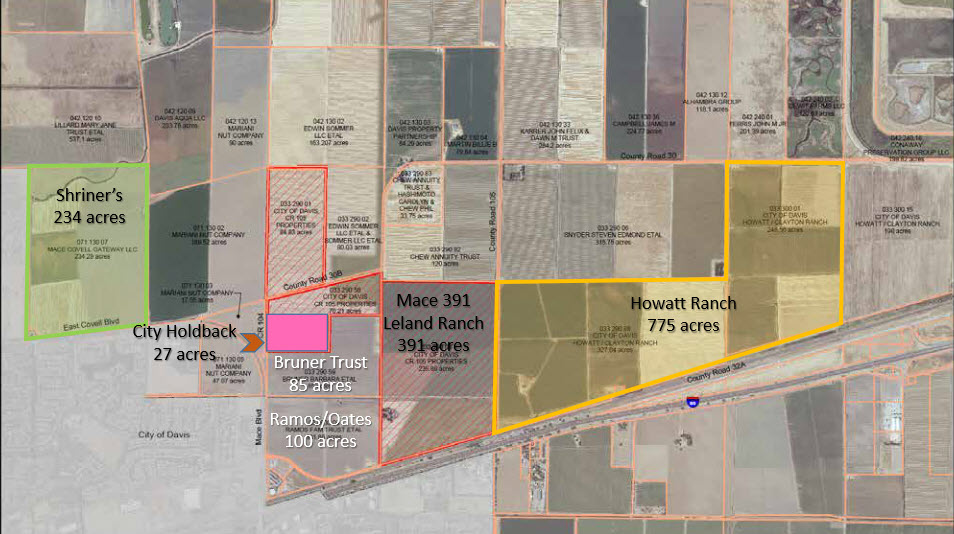

by Matt Williams
Doby Fleeman and Don Shor insisted on bringing up Mace 391 in the comments threads of yesterday’s article, and rather than burying my personal thoughts as one more comment in a somewhat tangentially related thread, here are those thoughts as an on-topic article … and just so I can have a little bit of personal fun, let me be crystal clear that the two-part topic of the article is (1) conflict of interest, and (2) how and why Davis is an example of “sustainable decadences.”
Let’s deal with the conflict of interest topic first. In yesterday’s comments Don Shor referred to the Mace 391 process as a “long-planned, fully-vetted, thoroughly-discussed plan to put Mace 391 into permanent ag conservation status.” That description is about as accurate as the plan to have lots of government workers and foreign dignitaries pay to stay at Trump facilities in various parts of the world.
- Long-planned to be sure.
- Thoroughly-discussed away from the prying eyes also to be sure.
- Fully in compliance with the law? Questionable.
- Thoroughly-vetted? Not so much. About as thoroughly vetted as the Mace Mess was thoroughly vetted.

In reality, the Mace 391 process was two things. (1) a total cluster f**k, and (2) a battle between the forces of Snidely Whiplash on the one side and the forces of Boris Badenov on the other side. There wasn’t a Dudley Do-Right or a Rocket J. Squirrel to be seen anywhere.
There were staff members aligned with the Snidely Whiplash faction, and other staff members aligned with Boris Badenov. And to make matters worse there were Council members whose allegiances were split between Snidely and Boris as well.
Dirty tricks were the rule rather than the exception on both sides, as was a firm adherence to the belief that “what you don’t know will hurt you.” That belief applied to both the public as a whole, as well as others in the governmental structure(s). The process that the City and the USDA were using to affect the transfer of money and the transfer of title was of questionable legality. But, what is done is done.
So when Doby argues for a “process whereby the Pros and Cons can be thoughtfully compared and considered before a final decision” he is out of sync with the context and the personal interests of that day and that transaction. Doby’s term apples to apples comparison would better describe what was actually happening at the time, if he called it a Shiite to Sunni comparison.
Enough with the conflict of interest. Let’s move on to “sustainable decadence.”
With all the above said, I do agree with Doby that today, the parallels to the high-level Mace 391 situation are undeniable. Once again, we are presented with a valuable opportunity to assess both our current status and to consider our strategies and options going forward, as we chart a future course for the City and the Community. But that opportunity comes with a problem.
The problem is that Davis is very well described by New York Times columnist Ross Douthat in his new book The Decadent Society, which has been described as “a powerful portrait of how our age in human history, so superficially turbulent, is actually defined by stagnation, repetition, deadlocks, and decay.” Tell me whether you believe the following quote describes Davis?
The Decadent Society explains what happens when a rich and powerful society ceases advancing—how the combination of wealth and technological proficiency with economic stagnation, political stalemates, cultural exhaustion, and demographic decline creates a strange kind of “sustainable decadence,” a civilizational malaise that could endure for longer than we think.
If that is an arguably good description of Davis, what are we to do about it? One possibility is to simply accept that as a reasonable description (and future) for Davis. Another possibility is to take steps to be honest with ourselves. Let’s drill down a bit into that second possibility.
Last Friday, right here in the Vanguard, we read the following about the City’s overall fiscal and economic picture (bold added to emphasize key points):
What does Dan Carson see as the solution? He said it was what we’ve been talking about for years.
“The two big things really are, pursuit of economic development that can generate economic revenues that don’t have to come out of tax rate increase, and really smart budgeting,” Dan Carson said.
He said there will be a big announcement coming up on one of the new tenants at one of the other Nugget Market sites. “We’ve landed other big AgTech firms,” he said. “The two hotels. We’re doing real stuff. He said the spigot will be on soon for the new Residence Inn up by Mace. Within a year Hyatt House will be up and going. Cannabis is going to provide double the general fund benefit, $1 million per year. “This is real scorable stuff. It’s not rhetoric.”
He also mentioned the Downtown Plan, which is more than halfway done.
“We are seeing all the signs that people are waiting for us to do the hard work… that could really accelerate what can happen there in terms of investment,” he said. The key, he said, is eliminate the uncertainty of zoning. “We’re hearing a lot swirling around… First we need to (present) the plan.
“That’s how we’re going to get the money,” he said.
What is the reality behind Council member Carson’s words. First, let’s start with the “decay” part of Douthat’s Decadent Society. In the July 2019 City Budget, the City quantified the amount of “decay” to our roads and greenways and buildings and parks that we have no money to pay for. That reported shortfall amount was $201 million (over 20 years). Only six months later, in a January 2020 presentation to the Finance and Budget Commission (FBC), the City’s fiscal consultant told the FBC that the amount of “decay” that we don’t have money to address rose over 25%, from $201 million to $258 million.
As if that $57 million increase weren’t bad enough, the only way that the amount of unfunded “decay” was kept down to $258 million, was because the annual $1 million of Cannabis benefit to the General Fund was included, as was the annual $1.2 million of SB-1 Gas Tax revenue. Without those two additional revenue sources the decay amount would have grown by another $44 million, and topped $300 million.
So, the honest statement to ourselves would be to say “This is real scorable stuff. It’s not rhetoric … but it is also stuff/money that we have already spent.”
What about that “really smart budgeting“? How honest are we being there? Is the Mace Mess an indication of smart budgeting? Are the building repairs at the Civic Center Gym an indication of smart budgeting? Are the roof repairs at Veterans Memorial an indication of smart budgeting? Is the failure of the 2016 Transportation Tax an indication of smart budgeting? Is the recent failure of DJUSD’s Measure G an indication of smart budgeting?
Robb Davis worked really, really hard, with all his heart and soul and mind when he was on the Council to get the City to embrace Cost Containment. All his powerful entreaties fell on deaf ears.
Until we are honest with ourselves about how we got to our current situation of economic stagnation, political stalemates, cultural exhaustion, and demographic decline (an honest assessment that Doby has been arguing for for years) we will have to be satisfied with being a poster child for Ross Douthat’s “sustainable decadence.”






The “conflict of interest” part of this article is not well-defined.
Regarding unfunded liabilities (CALPERS and CALSTRS), well – good luck with that California!
Here’s the most recent article (dated 2/28) I could find via a brief search:
Read more here: http://www.sacbee.com/news/politics-government/the-state-worker/article240738951.html
Stock market is crashing again, today.
No water (drought again), no money, but plenty of virus.
Yes Ron. I read an article recently where the author tried to claim that a majority of Americans don’t own any stocks so the market crash is only hurting the more well to do. People are more invested in the stock market than they know. One could be a teacher or public city worker and not own stocks individually but their retirement funds are heavily invested in stocks. So yes, most of the country is invested in the stock market one way or another.
Ron Oertel said . . . The “conflict of interest” part of this article is not well-defined.
That was a conscious choice on my part Ron. It leaves plenty of room for you to provide the additional information to make it well-defined … ideally with links to industry standards (sources).
It’s your article, Matt.
There isn’t “one” standard. But, unexplained references to cartoons (and “cluster f**k”) aren’t one of them.
Regarding Mace 391, you’ve neglected failed to shed any light on the conflict of interest. When I read “let’s move on” in your article above, there was nothing to “move on” from.
Ron, you will illuminate plenty of conflict of interest if you do a little homework on the history of Mace 391 events working backward from the November 2013 decision by Council to proceed with the Conservation Easement to the events in 2010 and 2011 that resulted in the purchase of the 391 acre Leland Ranch. The choice whether or not to do so is yours.
My intent with the first part of the article was not to provide a history lesson, but rather to make the point that there were bad actions on both sides of the issue. There isn’t any moral high ground, only human nature doing what human nature naturally does.
Interestingly, you haven’t made any comment on the second half of the article … the “sustainable decadence” part. Is that by choice, or by chance?
Again, no explanation regarding your claims of “conflict of interest”. Seems like you have trouble acknowledging this.
Apparently, I’m not the only one who finds your article difficult-to-follow. I also found the “sustainable decadence” comment to be rather strange. Isn’t the argument that things aren’t sustainable?
I did address the problems faced by cities (and probably school districts) throughout California, which no doubt will be exacerbated by the economic crash.
Ron, I would encourage you to read the book, or at the very least reviews of the book.
The nature of sustainable decadence is very clearly described in the quote I included in the article. The book …
Doby Fleeman and others have made the case that Davis began the process of ceasing to advance approximately two decades ago at the turn of the Century.
The “Davis premium” that has consistently been an element of the cost of housing when compared with the surrounding communities is a clear indicator of wealth in the community, and no one would argue that Davis has below average technological proficiency.
Another proxy for our community’s wealth is the extensive greenbelt/bikeways network we enjoy the use of.
And the most recent Treasurer’s Report for the City shows we have over $150 million of cash assets in the City’s various reserve funds.
Doby has made the argument that many of the key economic indicators point to economic stagnation. In addition, the fiscal feasibility analysis prepared by BAE for the Downtown Plan Advisory Committee showed nine out of ten redevelopment scenarios that didn’t generate enough revenues to cover the costs. Would you argue that Davis is not experiencing economic stagnation?
Political stalemates in our community are the rule rather than the exception, and the last two elections have seen those stalemates manifest themselves in the defeat of the City Transportation Tax and the DJUSD Measure G Tax.
We clearly are experiencing demographic decline, as our proportion of retirees has grown and our proportion of UCD students has grown, while our proportion (and absolute number) of familial parents has declined and our proportion (and absolute number) of pre-college children has declined.
The reason Ross Douthat refers to this clear decadence as “sustainable” is that we have the option of continuing to eat our young for quite a while before things get really desperate.
Matt: My comment noted the lack of any explained conflict of interest, in your article.
Regarding this quote:
Perhaps the question is – why pursue it, then? Why not pursue more intense commercial uses, instead? (Same question regarding University Mall, Hibbert’s site, etc.)
Regarding this quote:
The stock market (and possibly the housing market to follow) are in a state of global collapse.
Having fewer children per household is a trend throughout California (and some countries, as well). That’s not going to change, nor should it be a “goal”. Relying upon continued growth in population and related development is exactly what’s led to fiscal problems, to begin with. It’s not a sustainable path.
However, demographics do change, over time. There’s not an unlimited supply of old farts, and they tend to die-off after awhile. There may be a period of “adjustment”, in between.
Again, unfunded liabilities are a problem throughout California, including in communities that have pursued a great deal of “economic development”. Much of this is due to unrealistic expectations regarding costs and funding of pensions and medical benefits. As the stock market collapses, this problem will become more exposed.
Personally, I don’t think it’s fair to expect young people to continue to “bail out” older generations, either (in some sort of misguided Ponzi scheme).
Ron Oertel said . . . Again, no explanation regarding your claims of “conflict of interest”. Seems like you have trouble acknowledging this.
and
Matt: My comment noted the lack of any explained conflict of interest, in your article.
I answered your question TWICE Ron.
Once at 12:39pm and a second time at 1:02pm. For your reading convenience, here are both those answers:
.
and
This is an acknowledgement that your article in no way whatsoever addresses the claim you put forth regarding conflict of interest (e.g., in the title of your article). In general, readers aren’t going to research your claims for you.
That, plus the other nonsense you’ve put forth in the first part of your article demonstrates sloppiness and a lack of effort. Same thing is true regarding “sustainable decadence”, although you’ve since explained what that meant.
It’s not a crime to submit a poorly-written article.
Ron posted:
Good point Ron…
Ron Oertel said . . . This is an acknowledgement that your article in no way whatsoever addresses the claim you put forth regarding conflict of interest (e.g., in the title of your article). In general, readers aren’t going to research your claims for you.
If readers choose not to pick up the thrown down gauntlet, then that is their loss Ron. The purpose of the article was to get people to ask themselves questions. It appears to have achieved that goal.
Ron Oertel said … That, plus the other nonsense you’ve put forth in the first part of your article demonstrates sloppiness and a lack of effort.
No, Ron. All it demonstrates is that I had no intention of providing the answers you crave. It was/is/and forever shall be my intention to leave that task to you.
Ron Oertel said . . . It’s not a crime to submit a poorly-written article.
I whole-heartedly agree.
So, apparently not so clear.
Topic, Ron. Topic.
You are looking for something that the author never intended to be there.
With that said, if it floats your boat, please be my guest.
I do, however, appreciate the posting of the map. It shows some of the next properties that would likely be developed, if ARC is approved (e.g., Shriner’s, and possibly Mariani’s?).
Mariani Nut owns all three parcels shown highlighted in gold. The note refers only to one of them in terms of acreage and land value.
Thanks, Don. Based upon the coloring, it does appear to show a parcel extending to to the other side of Mace. Seems like a low-value per acre.
I’m assuming that the division of the parcels preceded the construction of the road. (I’ve seen this situation elsewhere, as well. It’s often unfortunate, when that’s allowed to occur.)
Given the value of land that could be annexed, it would seem worthwhile to subdivide the piece inside the curve as a separate parcel, for development. I suspect that there’d be very little opposition, to that. (It’s certainly not a practical piece for a normal commercial farm.)
I’ve been wondering for years, regarding the reason that the property inside the curve hadn’t been developed.
Ron, two additional pieces of detail
(1) $22,796 per acre is pretty close to the current per acre value of orchard land … Mariani Nut’s principal use of its extensive inventory of land throughout Yolo County.
(2) I believe if you go to the County Clerk’s office you will find that Mariani Nut purchased the two parcels outside the Mace Curve (APN 071-130-002 and APN 071-130-003) several years prior to the date when they purchased the parcel inside the Mace Curve (APN 071-130-005). I also believe the prior owners of APN 071-130-002 and APN 071-130-003 were different from the prior owner of APN 071-130-005.
Thanks, Matt.
So, the parcel inside the curve (ending in “005”, inside the curve) is a separate parcel. I wonder what circumstances led Mariani to purchase it at a later date (and possibly from a separate owner)? It’s obviously not going to be an almond orchard.
I don’t recall what’s growing on parcel “003”.
Is Mariani occasionally in the business of turning orchards into developments?
maybe get rid of the stupid curve and restore the property to its former glory as a rectangle
Matt: Not really following your piece all that well. What are you referring to as the conflict of interest – the Mace 391 in my view was a good idea, but rolled out extremely poorly which forced the council to go ahead with the conservation easement and vote against reconsideration.
Ron: I attached the map to Matt’s piece. I don’t think Shriner’s is that likely to be development, too much ownership issues there.
David: Not sure what you mean by “ownership issues”. In any case, – when there’s money to be made, ownership issues tend to “disappear”. It doesn’t seem to be an issue regarding the multiple owners of ARC.
What’s your opinion of the likelihood of development of the adjacent Mariani property? And, does that property extend inside the Mace curve? If so, why hasn’t the property inside the curve been “separated” from the site outside the curve?
I have heard conflicting information regarding the property inside the curve, and whether or not it extends across the street. Also, do you know how large that property is (adjacent to the junior high)?
I do or can easily find (as you could)… which adjacency? To the east? North? Both?
All public record… see my 5:17 post. And what you wrote that preceded that…
How about on the other side of Mace (outside of the curve)? And, if you know the answers, why not share them (instead of sniping)?
There’s a map in the article, above. It appears to show the same owner. Is the property inside the curve a separate parcel? If so, why is that the case?
If you have nothing of value to add, then why not refrain from commenting in the first place? (Apparently, quite a challenge for you to do so, in reference to your 5:17 p.m. post – and just about all others as well.)
I meant to ask, why isn’t the property inside the curve a separate parcel? That would make it easier (and more logical) to develop, separately.
That property (while inside the curve) is outside of city limits, and is not included in the so-called “inventory” of undeveloped city land.
The curve was created after the parcel was created.
David, reconsideration of the 2010 Council decision on Mace 391 (Leland Ranch) was always going to be a difficult “lift” especially with Joe Krovoza as Mayor. It would have been difficult if both sides were transparent about their respective agendas, but transparency was the antithesis of what was provided.
That lack of transparency was particularly egregious during the period of time when the Innovation Park Task Force was conducting its meetings. The in-process steps being taken by staff and others with the USDA to bring the Conservation Easement to fruition were never transparently shared with that Task Force. If you look through the Task Force’s Background and Reference Documents on the City website, nothing on Leland Ranch appears. I’m pretty sure that the Studio 30 report has no reference to the Conservation Easement possibilities either. I’m not sure if the description of what went on should be the “blind leading the blind” or “the blind misleading the blind.”
However, that is all ancient history. The really important part of the article is, in my opinion, the part that follows the label Enough with the conflict of interest. Let’s move on to “sustainable decadence.”
Matt, I couldn’t help but thinking of Mr. Peabody when I saw your header cartoon.
A very logical association Keith. 8>)